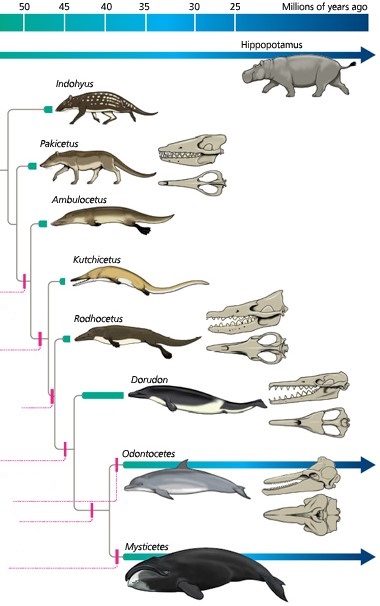Evolution – pretty cool agreed? It’s fascinating to think that humans share a direct lineage with chimpanzees, reptiles are related to birds, and even that whales & dolphins definitely AREN’T related to fish!
Ever since Charles Darwin had his famous light bulb moment, and scribbled out a little branched diagram next to the words “I think”, scientists have set about piecing together the evolutionary history of animals.
The first important step came in 1861 when ‘The Missing Link’ was discovered – Archaeopteryx, the feathered lizard. Because this was the first fossil showing an animal that had a foot in both camps (the bird family and the reptile family), it was taken as proof that evolution must be the system that gives us animals perfectly adapted to their modern-day environments.
The evolutionary story of whales goes something like this –
- there once was a group of animals called Mesonychids. They were furry with four legs and a tail, and looked a lot like a wolves, but they had hooves. They lived in swampy areas in the Tethys Sea (modern day Mediterranean), and spent most of their days paddling around and eating little fishies.
- Gradually the mesonychids relied more and more on their swimming skills, until they spent so much time foraging underwater that their bodies began to change. They got longer and thinner so that they would be more streamlined. Their front legs got flatter so they could be used as paddles, and their useless back legs started to shrink. Their tails became wider and stronger to help push through the water. They swapped fur for insulating fat. And finally, their nostrils moved to the very tops of their heads to make breathing at the surface easier.

- About 50 million years ago, we ended up the first ancient animal that looks anything like a whale – the Archaeocete. They were nearly there, much better adapted to life underwater than the mesonychid, but not yet perfect: it’s thought that they still had little back legs, and they might even have climbed back onto land to breed, like seals do.
- About 25-30 million years ago, they split into Odontocetes, (toothed whales like orcas and dolphins) and Mysticetes (baleen whales that filter feed on tiny animals, like blue whales and humpback whales). By about 5 million years ago, all of the whales and dolphins you can see today had arrived.
For some mysterious reason, Archaeocetes and all of the other forms of primitive whales between them and present day whales died out, leaving us with only tiny fragments of bones, fossils, and the glorious Hippopotamus, as clues about how whales got here.

So, Hippos: They’re big and fat and they’re often found underwater. That’s pretty much where the similarity ends – but they’re actually really closely related to whales. Scientists reckon that Mesonychids (that wolf thing with hooves) evolved from a hippo-like animal back in the day… or approx. 60 million years ago. So out of all the land mammals in the world, the hippo is most closely related to the whale!
And when watching hippos you can find all sorts of clues that tell the evolutionary stories of their distant relations…
N.B. Anyone interested in finding out more on this subject can find looooads of cool stuff here and here!






